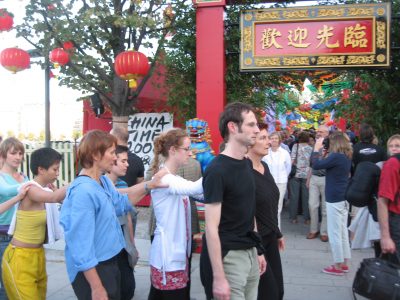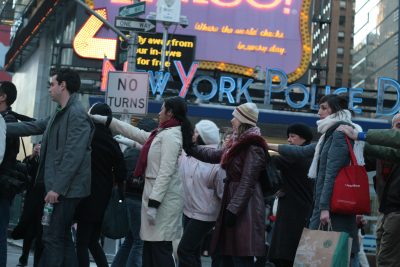“Avant-garde” in PERFORMA, New York
Avant-garde
As part of PERFORMA 07
Time: October 27 – November 21, 2007
Location: New York City
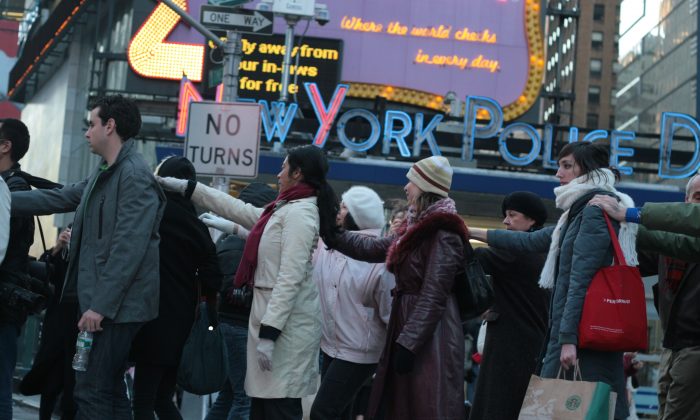
As contemporary Chinese art has moved rapidly into the international art world, with museums, galleries and auction houses celebrating new Chinese painting, sculpture and photography, it has become increasingly important to explain the broader political and social context that have produced these developments. Towards this end, PERFORMA has invited The Long March Project, a Beijing-based multi-platform international arts organization that is a curatorial laboratory, commissioning atelier, gallery space and publishing house, to present a series of performances and panel discussions as part of PERFORMA07. This will be the first major representation of The Long March Project in New York, and will build on PERFORMA’s network of consortium venues, connecting the dots between cultural organizations and their varied constituencies. Performances and panel discussions are specifically designed to question the exhibition and interpretation of Chinese art in a city with entrenched ties to China. PERFORMA and the Long March Project thus embark together upon a broader metaphorical ‘long march’ across New York City with performances and conversations at multiple venues, including China Institute, The Studio Museum in Harlem, Museum of Chinese in the Americas, and James Cohan Gallery.
Long March Project approached its participation in PERFORMA 07 by considering the idea of performance in the context of private and public spaces, and in relation to the everyday. In the spirit of PERFORMA’s conceptual inquiry, namely to go beyond the spaces / mediums that have been previously designated to performance art, Long March Project began by interpreting performance in its relation to conceptual spaces that may be geographically present, but whose meanings are often abstract, ephemeral entities. Spaces such as local and international, urban and rural, where in the spaces between the ideas of public space and performative spaces are in constant flux and negotiation.
In this sense, this approach pays homage to the spirit of the origins of performance art in the late 1960s which, amidst an increasingly institutional, commercialized art world and market, sought more ephemeral, immediate ways of artistic expression.
Long March Collective
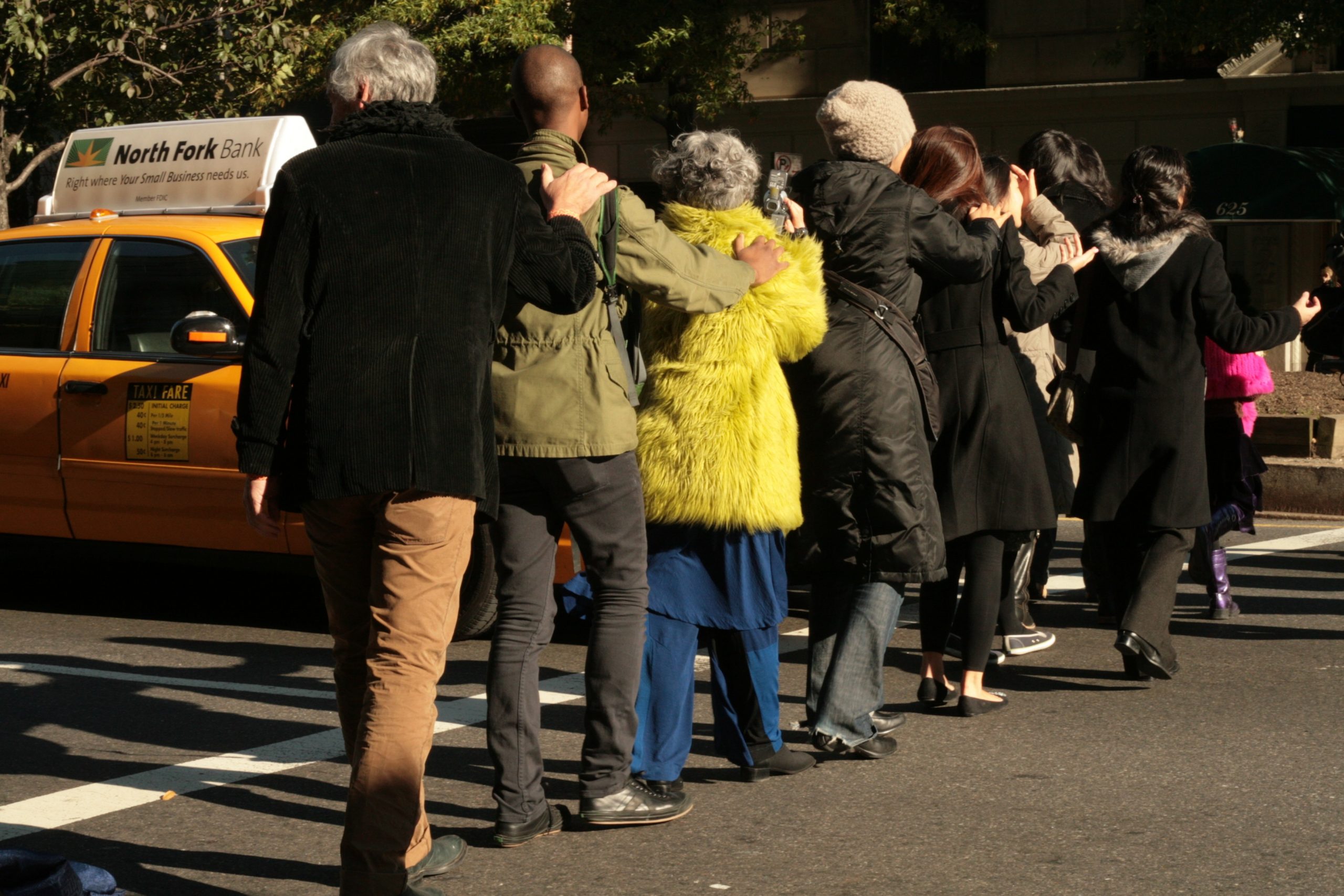
Long March Collective, Avant-Garde
Chiefly introducing the educational component of the Long March’s participation in the PERFORMA07, Long March Project: Avant-garde was comprised of a public workshop and performative ‘march’. The symposium/workshop was led by a panel of Long March artists and curators including Lu Jie, Qiu Zhijie, and artist Ingo Gunther, who introduced the Long March’s investigations and concerns, past projects and methodologies. Through an open discussion with the participants they engaged in a self-critical dialogue concerning the dilemmas, implications, desires, and approaches to avant-garde and performance art in an individual and public context. collaborative product of the workshop was the march itself, where participants walked single file in reverse – a backwards march – on a route determined by the participants. The decision was based on the dialogue between the panel and the public concerning the local areas and inhabitants of New York City and the socio-cultural implications of marching through these areas. Through the physical act of marching, participants will map the geography and the history and negotiations of those areas of New York City.
Zhao Gang
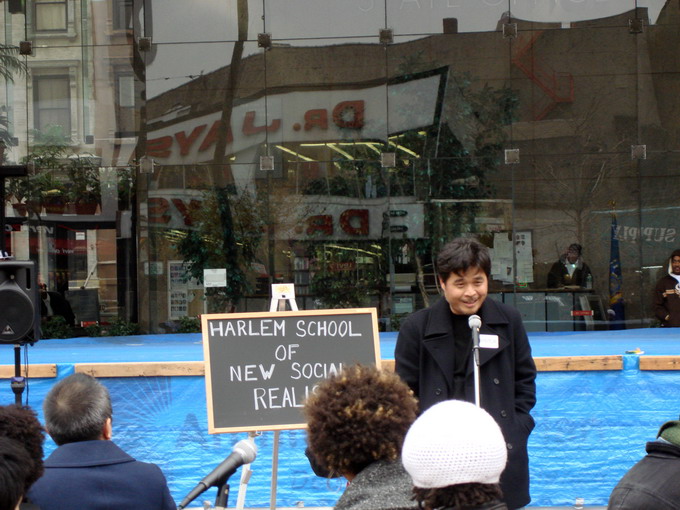 Gang Zhao, Harlem School of New Social Realism
Gang Zhao, Harlem School of New Social Realism
The Harlem School of New Social Realism was first initiated by artist Gang Zhao in his home in Harlem NY during the summer of 2002. The work focuses on many conceptual and theoretical issues parallel to the Long March’s own contradictions and problems. Idealism and reality, knowledge and society, self and public are the problems encountered by the historical Long March; these are also the challenges that today’s Long March faces. The work involved a discussion between a group of black and Asian artists and thinkers in America that ultimately ended without conclusion in a discussion regarding black artists from America joining the Long March. The process of the meeting and its final result was a performance of a failed idealism.
For PERFORMA07, a new discussion will be organized, bringing together voices of critical thinkers, artists, and scholars to determine the possibilities of solidarity, as well as the boundaries of differences. The discussions were both exploratory and academic in nature, as well as “performative,” functioning as a platform to give voice to a new perspectives and ideas.
Xu Zhen
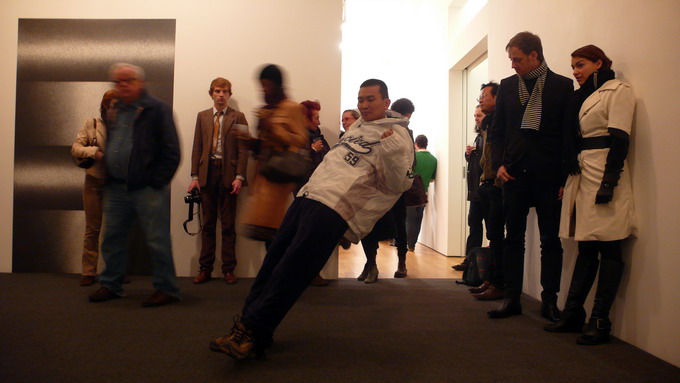 Xu Zhen, In Just a Blink of an Eye
Xu Zhen, In Just a Blink of an Eye
Four performers, recruited migrants from Chinatown, appeared in an empty room, literally suspended: frozen in time and space, and tilted at an impossible angle, as if ready to topple over.
This optical illusion suggests the liminal status of migrants within an undefined space. Their migration has been frozen and trapped. At the same time, the viewer’s subjectivity is called into question, acknowledging the power to freeze and create a snap shot, as if in the blink of an eye. At the same time, perhaps they are filled with an anxious need for resolution of this ‘suspended’, discomforting state. will these performers fall over – or will they remain stuck forever?
Qiu Zhijie
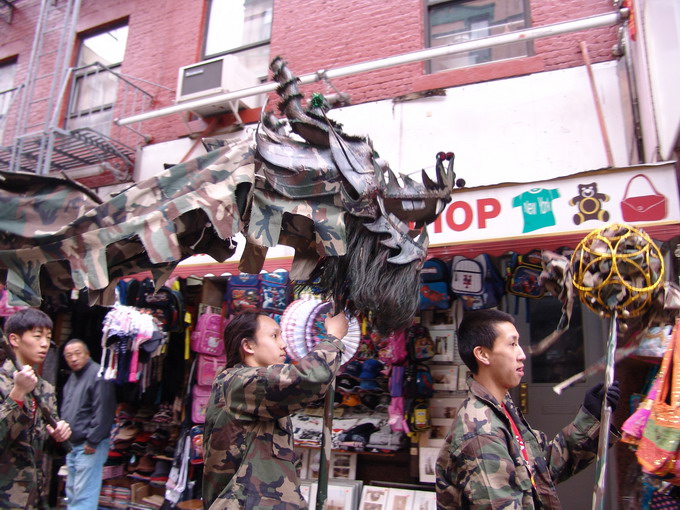 Qiu Zhijie, The Thunderstorm is Slowly Approaching
Qiu Zhijie, The Thunderstorm is Slowly Approaching
In Chinese tradition, the dragon is viewed as the god of wind and rain – dragon dances were held in the early spring to invite the rains, functioning as a way of bringing prosperity and good harvest. During the Ming Dynasty the dragon became to be a symbol of Imperial power, while still functioning as a symbol of peace and harmony. Through the artifice of camouflage (a seemingly militaristic motif), Qiu Zhijie investigates the game of hiding and transformation of culture and identity. To what extent is the disguise of subjectivity based upon a mutual deception? How are these facades interpreted, (mis)read, acted upon and reified into facts?
For PERFORMA07, artist Qiu Zhijie created The Thunderstorm is Slowly Approaching, a multimedia work encompassing installation, performance, and video to engage in the specific social contexts of New York. A ceremonial dragon dance costume, made from camouflage hung on a camouflage colored wall. 10 individuals, clad in army fatigues, then entered the space, removed the costume, and performed a Dragon Dance down to the Columbus Paviion in New York’s Chinatown. Upon completing the performance, the costume was returned to its original position, thereby creating a process of hiding, unveiling and hiding once again. Qiu enacted a similar performance at the 2005 Yokohama Triennial, where he conducted a lion dance on the streets of Yokohama’s Chinatown.
As a symbol of aggression and celebration, the lion dance provocatively unfolded the history of Japanese imperialism in the Pacific Region. For New York, The Thunderstorm is Slowly Approaching engages with the unique, multicultural framework of United States social policy, while also being wary of its militarism and stringent, post-9-11 immigration policies, in a manner that is both critical and festively celebratory, in the spirit of PERFORMA 07.
As contemporary Chinese art has moved rapidly into the international art world, with museums, galleries and auction houses celebrating new Chinese painting, sculpture and photography, it has become increasingly important to explain the broader political and social context that have produced these developments. Towards this end, PERFORMA has invited The Long March Project, a Beijing-based multi-platform international arts organization that is a curatorial laboratory, commissioning atelier, gallery space and publishing house, to present a series of performances and panel discussions as part of PERFORMA07. This will be the first major representation of The Long March Project in New York, and will build on PERFORMA’s network of consortium venues, connecting the dots between cultural organizations and their varied constituencies. Performances and panel discussions are specifically designed to question the exhibition and interpretation of Chinese art in a city with entrenched ties to China. PERFORMA and the Long March Project thus embark together upon a broader metaphorical ‘long march’ across New York City with performances and conversations at multiple venues, including China Institute, The Studio Museum in Harlem, Museum of Chinese in the Americas, and James Cohan Gallery.
Long March Project approached its participation in PERFORMA 07 by considering the idea of performance in the context of private and public spaces, and in relation to the everyday. In the spirit of PERFORMA’s conceptual inquiry, namely to go beyond the spaces / mediums that have been previously designated to performance art, Long March Project began by interpreting performance in its relation to conceptual spaces that may be geographically present, but whose meanings are often abstract, ephemeral entities. Spaces such as local and international, urban and rural, where in the spaces between the ideas of public space and performative spaces are in constant flux and negotiation.
In this sense, this approach pays homage to the spirit of the origins of performance art in the late 1960s which, amidst an increasingly institutional, commercialized art world and market, sought more ephemeral, immediate ways of artistic expression.
Long March Collective

Long March Collective, Avant-Garde
Chiefly introducing the educational component of the Long March’s participation in the PERFORMA07, Long March Project: Avant-garde was comprised of a public workshop and performative ‘march’. The symposium/workshop was led by a panel of Long March artists and curators including Lu Jie, Qiu Zhijie, and artist Ingo Gunther, who introduced the Long March’s investigations and concerns, past projects and methodologies. Through an open discussion with the participants they engaged in a self-critical dialogue concerning the dilemmas, implications, desires, and approaches to avant-garde and performance art in an individual and public context. collaborative product of the workshop was the march itself, where participants walked single file in reverse – a backwards march – on a route determined by the participants. The decision was based on the dialogue between the panel and the public concerning the local areas and inhabitants of New York City and the socio-cultural implications of marching through these areas. Through the physical act of marching, participants will map the geography and the history and negotiations of those areas of New York City.
Zhao Gang
 Gang Zhao, Harlem School of New Social Realism
Gang Zhao, Harlem School of New Social Realism
The Harlem School of New Social Realism was first initiated by artist Gang Zhao in his home in Harlem NY during the summer of 2002. The work focuses on many conceptual and theoretical issues parallel to the Long March’s own contradictions and problems. Idealism and reality, knowledge and society, self and public are the problems encountered by the historical Long March; these are also the challenges that today’s Long March faces. The work involved a discussion between a group of black and Asian artists and thinkers in America that ultimately ended without conclusion in a discussion regarding black artists from America joining the Long March. The process of the meeting and its final result was a performance of a failed idealism.
For PERFORMA07, a new discussion will be organized, bringing together voices of critical thinkers, artists, and scholars to determine the possibilities of solidarity, as well as the boundaries of differences. The discussions were both exploratory and academic in nature, as well as “performative,” functioning as a platform to give voice to a new perspectives and ideas.
Xu Zhen
 Xu Zhen, In Just a Blink of an Eye
Xu Zhen, In Just a Blink of an Eye
Four performers, recruited migrants from Chinatown, appeared in an empty room, literally suspended: frozen in time and space, and tilted at an impossible angle, as if ready to topple over.
This optical illusion suggests the liminal status of migrants within an undefined space. Their migration has been frozen and trapped. At the same time, the viewer’s subjectivity is called into question, acknowledging the power to freeze and create a snap shot, as if in the blink of an eye. At the same time, perhaps they are filled with an anxious need for resolution of this ‘suspended’, discomforting state. will these performers fall over – or will they remain stuck forever?
Qiu Zhijie
 Qiu Zhijie, The Thunderstorm is Slowly Approaching
Qiu Zhijie, The Thunderstorm is Slowly Approaching
In Chinese tradition, the dragon is viewed as the god of wind and rain – dragon dances were held in the early spring to invite the rains, functioning as a way of bringing prosperity and good harvest. During the Ming Dynasty the dragon became to be a symbol of Imperial power, while still functioning as a symbol of peace and harmony. Through the artifice of camouflage (a seemingly militaristic motif), Qiu Zhijie investigates the game of hiding and transformation of culture and identity. To what extent is the disguise of subjectivity based upon a mutual deception? How are these facades interpreted, (mis)read, acted upon and reified into facts?
For PERFORMA07, artist Qiu Zhijie created The Thunderstorm is Slowly Approaching, a multimedia work encompassing installation, performance, and video to engage in the specific social contexts of New York. A ceremonial dragon dance costume, made from camouflage hung on a camouflage colored wall. 10 individuals, clad in army fatigues, then entered the space, removed the costume, and performed a Dragon Dance down to the Columbus Paviion in New York’s Chinatown. Upon completing the performance, the costume was returned to its original position, thereby creating a process of hiding, unveiling and hiding once again. Qiu enacted a similar performance at the 2005 Yokohama Triennial, where he conducted a lion dance on the streets of Yokohama’s Chinatown.
As a symbol of aggression and celebration, the lion dance provocatively unfolded the history of Japanese imperialism in the Pacific Region. For New York, The Thunderstorm is Slowly Approaching engages with the unique, multicultural framework of United States social policy, while also being wary of its militarism and stringent, post-9-11 immigration policies, in a manner that is both critical and festively celebratory, in the spirit of PERFORMA 07.

